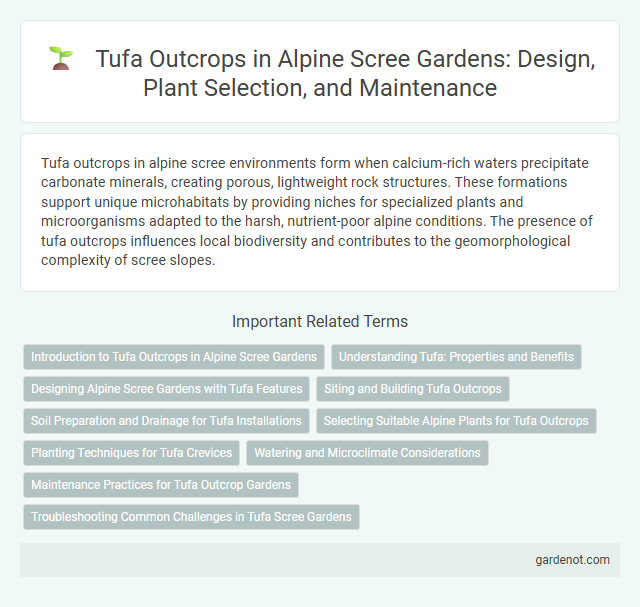Tufa outcrops in alpine scree environments form when calcium-rich waters precipitate carbonate minerals, creating porous, lightweight rock structures. These formations support unique microhabitats by providing niches for specialized plants and microorganisms adapted to the harsh, nutrient-poor alpine conditions. The presence of tufa outcrops influences local biodiversity and contributes to the geomorphological complexity of scree slopes.
Introduction to Tufa Outcrops in Alpine Scree Gardens
Tufa outcrops in Alpine scree gardens form porous limestone deposits created by the precipitation of calcium carbonate from mineral-rich waters. These unique geological features support specialized microhabitats, promoting biodiversity by providing niches for rare alpine plants and mosses. Their formation is influenced by cold, fast-draining conditions typical of scree environments, making them vital components of alpine ecological systems.
Understanding Tufa: Properties and Benefits
Tufa is a porous, calcium carbonate rock commonly forming in Alpine scree environments through rapid precipitation of carbonate minerals from freshwater springs. Its lightweight structure and high porosity provide excellent insulation and water retention properties, benefiting local flora and fauna by maintaining moisture in otherwise dry scree slopes. Understanding tufa's formation and characteristics helps in ecological conservation and studying carbonate sedimentary processes in mountainous regions.
Designing Alpine Scree Gardens with Tufa Features
Tufa outcrops serve as natural focal points in alpine scree gardens, offering porous, lightweight rock ideal for drainage and root aeration. Integrating tufa into garden design enhances moisture retention while providing a rugged, textured aesthetic that mimics alpine environments. Strategically positioning tufa allows for planting diverse alpine flora, supporting their growth in well-drained, mineral-rich substrates essential for scree garden success.
Siting and Building Tufa Outcrops
Tufa outcrops in alpine scree environments are ideally sited in areas with consistent water flow and abundant calcium carbonate-rich sources, typically near springs or seepage zones where mineral-laden water precipitates calcite. Building tufa outcrops involves careful layering of precipitated calcite and organic materials, utilizing natural substrates such as moss or algae mats to facilitate calcification and structural stability. Optimal placement and growth depend on maintaining a stable microclimate with sufficient moisture, pH levels, and minimal disturbance to promote continuous tufa deposition and outcrop development.
Soil Preparation and Drainage for Tufa Installations
Tufa outcrops require well-prepared soils with high porosity to ensure adequate drainage and prevent waterlogging. Incorporating coarse, mineral-rich substrates such as gravel and sand enhances aeration and mimics natural scree conditions. Proper drainage systems are essential to replicate the alpine microenvironment, promoting healthy root development and stability in tufa installations.
Selecting Suitable Alpine Plants for Tufa Outcrops
Tufa outcrops in alpine scree environments require selecting plants adapted to calcareous, porous substrates that retain moisture yet drain quickly. Species such as Saxifraga paniculata, Festuca rupicola, and Campanula scheuchzeri thrive on these calcium-rich surfaces due to their tolerance to alkaline soil conditions and drought resistance. Establishing vegetation with these species supports soil stabilization and enhances biodiversity on fragile tufa formations.
Planting Techniques for Tufa Crevices
Tufa outcrops offer unique microhabitats with porous crevices ideal for specialized alpine plant species. Effective planting techniques for tufa crevices involve selecting drought-tolerant, low-maintenance alpine flora such as Saxifraga and Sedum, which thrive in well-drained, mineral-rich surfaces. Ensuring minimal soil addition and carefully positioning plants to maximize root anchorage promotes successful establishment and long-term growth in these fragile scree environments.
Watering and Microclimate Considerations
Tufa outcrops in Alpine scree environments retain moisture effectively, creating localized watering conditions essential for unique aquatic and terrestrial microhabitats. The porous nature of tufa facilitates slow water release, maintaining humidity levels that support specialized mosses and invertebrates. Microclimate variations around tufa formations influence temperature regulation and moisture availability, promoting biodiversity within otherwise arid scree slopes.
Maintenance Practices for Tufa Outcrop Gardens
Regular maintenance of tufa outcrop gardens in alpine scree environments involves careful monitoring of moisture levels to prevent desiccation while avoiding waterlogging, which can compromise the porous limestone structure. Pruning and removal of invasive species are essential to preserve native flora that thrive in nutrient-poor conditions typical of tufa formations. Periodic inspection for erosion and structural instability helps maintain the integrity of tufa outcrops and supports sustainable plant growth.
Troubleshooting Common Challenges in Tufa Scree Gardens
Tufa outcrops in alpine scree gardens often face challenges such as poor drainage and nutrient deficits, which can hinder plant growth and stability. Addressing these issues requires improving substrate porosity to prevent waterlogging and supplementing with appropriate minerals to mimic natural alpine conditions. Regular monitoring for erosion and adjusting irrigation schedules help maintain the delicate balance essential for thriving tufa-based ecosystems.
Tufa outcrop Infographic

 gardenot.com
gardenot.com